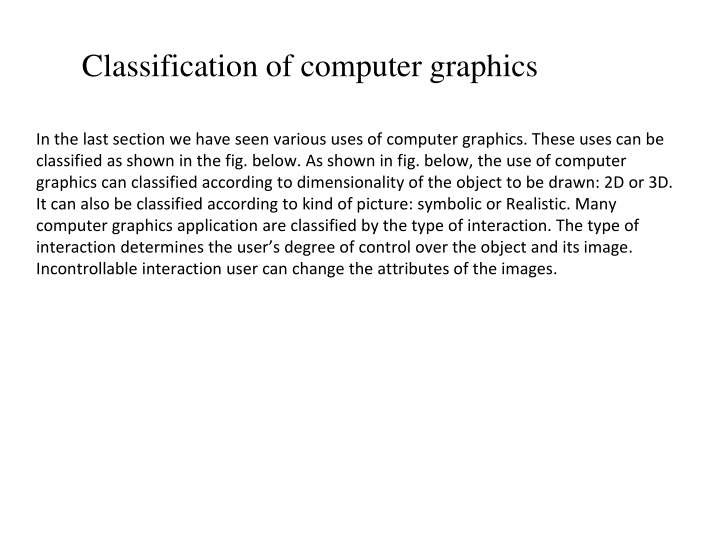
Reflection Transformation in Computer Graphics
Explore the classifications and concepts of reflection transformation in computer graphics, including 2D and 3D representation, symbolic vs. realistic images, and horizontal vs. vertical reflections. Learn how reflection operations affect images and objects in graphic design.
Uploaded on | 1 Views
Download Presentation

Please find below an Image/Link to download the presentation.
The content on the website is provided AS IS for your information and personal use only. It may not be sold, licensed, or shared on other websites without obtaining consent from the author. If you encounter any issues during the download, it is possible that the publisher has removed the file from their server.
You are allowed to download the files provided on this website for personal or commercial use, subject to the condition that they are used lawfully. All files are the property of their respective owners.
The content on the website is provided AS IS for your information and personal use only. It may not be sold, licensed, or shared on other websites without obtaining consent from the author.
E N D
Presentation Transcript
Classification of computer graphics In the last section we have seen various uses of computer graphics. These uses can be classified as shown in the fig. below. As shown in fig. below, the use of computer graphics can classified according to dimensionality of the object to be drawn: 2D or 3D. It can also be classified according to kind of picture: symbolic or Realistic. Many computer graphics application are classified by the type of interaction. The type of interaction determines the user s degree of control over the object and its image. Incontrollable interaction user can change the attributes of the images.
gives the another classification. Computer graphics is either used for representation or it can be an end product such as drawings. Pictorial representation gives the final classification of used computer graphics. It classifies the use of computer graphics to represent pictures such as line drawing, black and white, color and so on.
Reflection transformation Definition Reflection is the mirror image of original object. In other words, we can say that it is a rotation operation with 180 . In change. reflection transformation, the size of the object does not Basically the mirror image of any image for 2D reflection is generated with respect to the Axis of Reflection . For that we need to rotate main object 180 Degrees about the reflection axis.
T O P I C ReflectionT ransformation A n d C o m p o s i t eT ransformation
Let us understand from this example- As this image is reflecting with respect to the Y-axis, the reflection transformation obviously keeps Y-values same. But one must that, the image Flips 180 degrees and the values of Xof positions as shown figure. And similarly when the image with respect to X-axis. As mentioned in the aboveY-axis gets reflected with respect toY-axis and notice coordinate gets case, the point reflected obviously point getsflipped.
Types of reflection- Transformation in Computer Graphics Reflection is broadly classified in to Two Categories. They are, I. Horizontal Reflection II. VerticalReflection I. Horizontal Reflection: When Image gets flipped across, then the Image reflection is known `as Horizontal Reflection. And here image getsreflected axis. II. Vertical Reflection: When Image gets flipped up and down, the reflection is referred as Reflection. For easy understanding, we are providing which show both Horizontal and Vertical with respect to the Y - Vertical analysis, detailed image Reflections.
Matrix representation of reflection transformation- Computer Graphics Reflection transformation is generally implemented with respect to the coordinate axes or its coordinate origin as the scaling transformation with t minus (negative) scaling factors.
Reflection with respect to line- following figures show reflections with respect to X and Y axes, and about the originrespectively.
Composite Transformation transformation two or more transformations performed one after Sometimes, a composition of transformations is equivalent to a single transformation. The following is an example of a translation followed by a reflection. composite (or composition of A transformations)is the other. The original triangle is the brown triangle blue striped triangle. The brown striped triangle shows intermediate step after the translation has takenplace. and the image is the the
Let us understand composite transformation with this example- Example- Reflection through an arbitrary line. we have already discussed reflection through the line x=0, y=0 and y=x. All these lines passes through origin. But when reflection is to be performed about a line that neither passes through the origin nor parallel to the co-ordinate axis can be solved using the following steps- Step 1- Translate the line and the object so that the line passes through origin. Step 2- Rotate the line and the object about the origin until the coincident with one of the coordinate axis about familiar to perform reflection. Step 3- Reflect the object through the co-ordinate axis. line is we which are
Step 4-Apply the inverse rotation about the origin to shift the line at translated position. Step 5- Apply inverse translation to send back the object (i.e., line) to its original position matrixrotation. T = [TR ] * [Ro ] * [Rref] * [Ro-1 ] * [Tr-1] Where TR- Translationmatrix Ro- Matrix for rotation by angle O Rref Reflection about anyaxis R0 -1 - Inverserotation Tr-1- InverseTranslation
Example problem- of solving an composite transformation we have already understand about rotation, which occurs only about the origin but now our aim is to rotate the object a point other than origin. For this purpose homogeneous coordinate system will provide a method to accomplish rotation about any point. This can be done in the following order: Translate the object or body at the origin(i.e.,translation) Rotate by any angle as given(i.e.,Rotation) Translate back to its originallocation(i.e., Inverse Translation) Step1- Step2- Step3-
In matrix form, it can be shown as [T] = [TR][RO][TR]-1 = Translation matrix = Rotation matrix by an angle 0 = InverseTranslation matrix Where T R R O T-1 R
